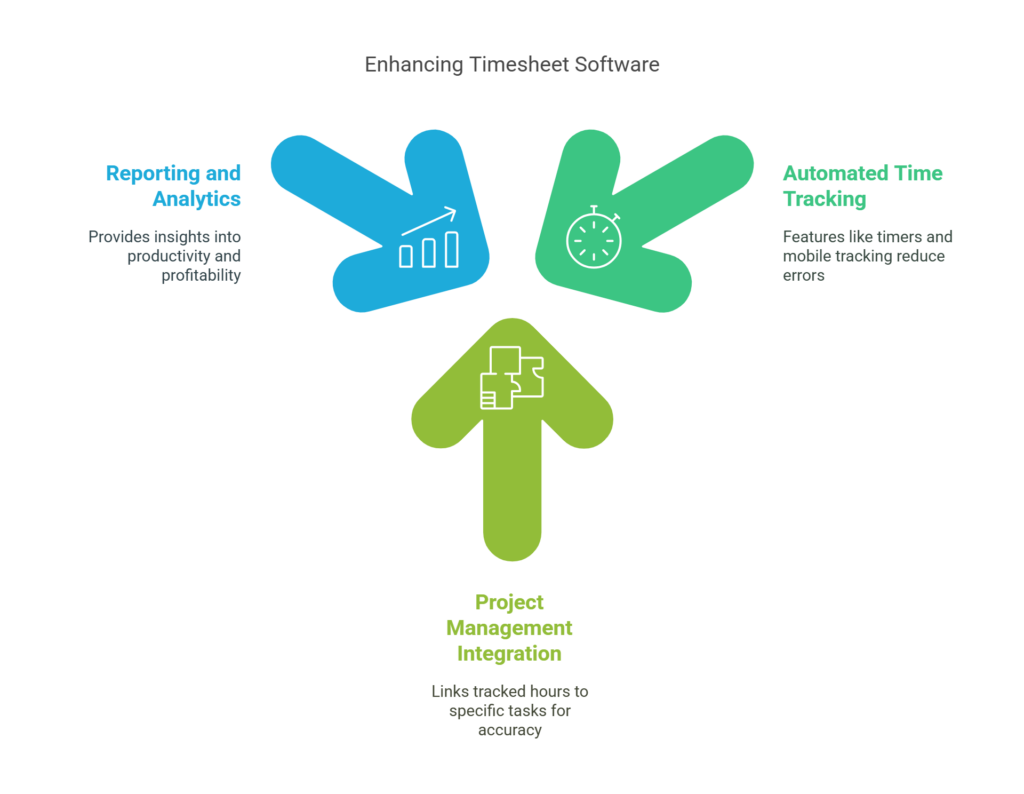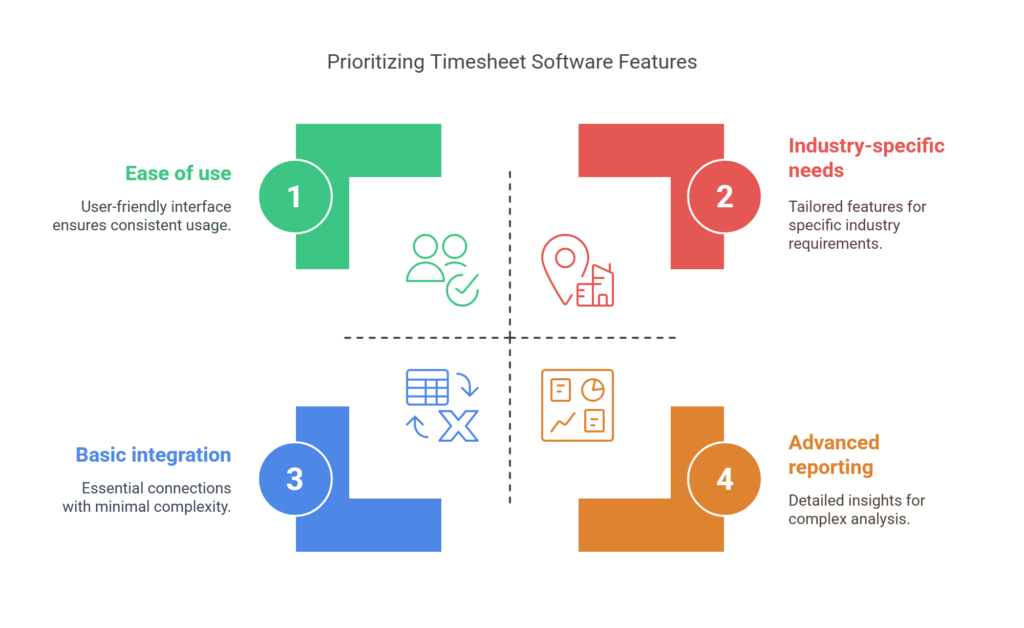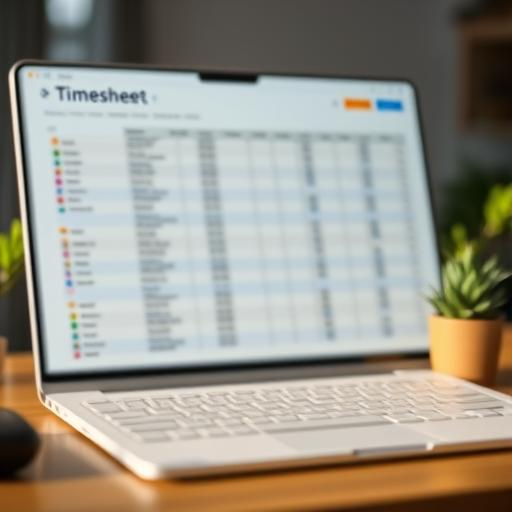Let’s face it, time really is money 💰. Businesses often lose both because of clunky, old-school time tracking methods. Did you know studies suggest manual time tracking can cost an average of 50 minutes per employee every single day? Ouch. Timesheet software presents a clear path forward, yet some companies drag their feet, worried about complexity or getting their teams on board. Here’s the real scoop: modern timesheet solutions can genuinely reshape your operations, give productivity a serious boost, and offer incredibly valuable insights. Stick around, and you’ll get the lowdown on picking the right system, getting it running smoothly, and unlocking its full power. It’s time to move past outdated ideas and focus on the real results and return on investment waiting for your business.
What is Timesheet Software?
At its heart, timesheet software is a digital tool designed to record the time employees spend on work tasks and projects. Think of it as a smart, automated version of the paper timesheet or messy spreadsheet. Its core job is to capture hours worked, often allowing users to assign that time to specific clients, projects, or activities. This creates a clear, digital record of where time—and consequently, money—is going.
Compared to traditional methods like paper logs or Excel files, timesheet software is leagues ahead. Manual tracking is prone to errors (who *really* remembers exactly when they started that task?), takes up valuable employee time just for logging, and offers zero real-time visibility. Digital timesheet solutions automate much of this, reducing inaccuracies and freeing up staff. Plus, they provide instant access to data for managers and finance teams.
“Time tracking software captures employee hours in real-time, making it easier for project managers to manage tight budgets and timelines.” -Harvest
Key Features of Modern Timesheet Solutions
Today’s timesheet software isn’t just a simple clock-in, clock-out system. Many offer automated time tracking features. This can include start/stop timers within the app, mobile tracking for field teams, or even background tracking that logs activity on work applications (with privacy controls, of course!). This automation drastically cuts down on manual entry errors and forgotten hours, making time data much more reliable.
Integration with project management is another game-changer. Imagine linking every tracked hour directly to a specific task within your project management tool. This gives you pinpoint accuracy on how much effort each part of a project is consuming. It’s vital for understanding project profitability, identifying bottlenecks, and project management integration effectively. No more guessing games about where the time went!

Powerful reporting and analytics capabilities are also standard. Good timesheet software can slice and dice your time data in various ways. You can generate reports on employee hours, project budgets versus actuals, client profitability, team productivity, and more. These insights help spot trends, make data-backed decisions about resource allocation, and refine estimates for future work. It moves time tracking from a chore to a strategic tool. 🤔
“Timesheet software provides unique features with incredible benefits for a company.” -WiFi Attendance
Benefits of Implementing Timesheet Software
One of the most immediate wins with timesheet software is improved accuracy. Manual methods are notorious for inaccuracies due to guesswork, rounding, or simply forgetting to log time. Automated tracking captures time precisely as it happens. This means fairer payroll for employees and spot-on billing for clients. Accurate data builds trust and prevents revenue leakage.
You’ll likely see a noticeable uptick in productivity too ✅. First, employees spend less time fiddling with manual logs or spreadsheets. Second, the data gathered can highlight where time is being spent inefficiently. Are certain tasks taking longer than expected? Are meetings eating up too much valuable work time? Identifying these patterns allows you to make adjustments and help your team focus on what matters most.
“Time tracking software can give insights to help you ward off issues before they become unmanageable.” -Harvest
Project management gets a serious upgrade. With real-time data on hours logged against projects and tasks, managers gain clear visibility into progress and budget consumption. They can see if a project is going over budget early on, not after it’s too late. This allows for proactive adjustments, better resource planning, and ultimately, more successful project delivery.
Billing and invoicing processes become smoother and faster. Since time is tracked accurately and often linked to specific clients or projects, generating detailed invoices is much simpler. Many systems can even create draft invoices automatically. This speeds up your billing cycle, improves cash flow, and reduces disputes with clients because the time data is clear and verifiable.
Choosing the Right Timesheet Software for Your Business
Okay, so you’re convinced, but how do you pick the *right* software? Start by clearly defining what problems you need to solve. Is inaccurate billing your main headache? Do you need better visibility into remote team productivity? Are you struggling with project budget overruns? Understanding your primary needs will help narrow down the options. Also, consider your business size and structure – a small team has different requirements than a large enterprise.
Next, weigh key factors. Ease of use is paramount; if the software is clunky or complicated, your team won’t use it consistently (or happily!). Check its integration capabilities – does it connect smoothly with your existing payroll, accounting, project management, or CRM software? Look at the reporting features – are they flexible enough to give you the insights you need? Don’t forget mobile access if you have teams on the go. And, naturally, consider the pricing model and whether it fits your budget.
Think about any industry-specific needs too. A construction company might need GPS tracking and site-specific clock-ins, while a creative agency might prioritize task-level tracking and client budget management. A sales-focused business might need software that automatically logs activities related to deals. Most vendors offer free trials or demos – take advantage of them! Test drive a few options with a small group to see which one feels like the best fit before choosing the *right* software.

Implementing Timesheet Software: Best Practices
Rolling out new software requires a thoughtful approach. Start with clear communication. Explain *why* you’re introducing the timesheet software – focus on the benefits for everyone involved, like easier tracking, fair pay, and better project clarity, not just management oversight. Provide thorough training sessions and easy-to-access resources. Getting team buy-in from the start makes a huge difference.
Consider a phased rollout rather than a big bang approach, especially for larger organizations. Start with a pilot team or department to work out any kinks and gather feedback. Plan your data migration carefully if you need to bring over existing project codes, client lists, or historical data. A clean setup prevents headaches down the road.
Set up those valuable integrations with your other business systems right from the beginning. Connecting timesheet data to payroll, project management tools, and accounting software unlocks the biggest efficiency gains. Establish clear policies on how and when time should be tracked to ensure consistency across the team. Make it easy for people to do the right thing.
Overcoming Common Challenges in Timesheet Software Adoption
You might encounter some bumps in the road. Employee resistance is a common one. This often comes from feeling watched or担心 privacy. Address this head-on with transparency. Reiterate the goals – efficiency, fairness, project success – and emphasize how the tool makes *their* jobs easier too. Choose user-friendly software that doesn’t feel overly intrusive.
Technical glitches or integration problems can also pop up. Select a reputable software provider known for reliability and good customer support 📞. Test integrations thoroughly during the setup phase. Designate an internal point person or small team who can help colleagues troubleshoot common issues and act as a liaison with the software vendor if needed.
Integrating Timesheet Software with Other Business Tools
The real power of timesheet software often comes from its ability to talk to other systems. When integrated with project management tools (like Asana, Jira, ClickUp), time entries automatically link to specific tasks. This gives managers a holistic view, combining task progress with the actual time spent, leading to much smarter resource allocation and deadline management.
Connecting timesheet software to your accounting and payroll systems is a massive time-saver. Imagine payroll hours flowing automatically, or invoices being generated based directly on approved timesheets. This eliminates duplicate data entry, drastically reduces the chance of errors, and speeds up critical financial processes like getting paid or paying your team accurately.
Future Trends in Timesheet Software
The world of timesheet software is always improving. We’re seeing more Artificial Intelligence (AI) and Machine Learning creeping in 💡. Think predictive analytics that estimate project completion times based on historical data, or tools that automatically suggest time entries based on your calendar or application usage. AI can also help spot anomalies or potential errors in time logs.
Mobile-first design continues to be a major trend. With more teams working remotely or in the field, having a seamless, intuitive mobile app for time tracking is essential. Features like geofencing (automatically clocking in/out when entering/leaving a work site) are becoming more common. The focus is on making time tracking effortless and accessible from anywhere.
How Nektar.io Revolutionizes Timesheet Management
While traditional timesheet software focuses broadly on tracking hours, solutions like Nektar.io approach time and activity tracking from a revenue operations perspective. It’s designed specifically to tackle the productivity and visibility challenges faced by sales teams and other revenue-generating functions. Nektar aims to automate the mundane task of logging activities, freeing up valuable selling time.
Instead of manual timers, Nektar.io often works by automatically capturing sales activities (emails, meetings, calls) and syncing them directly into your CRM. This functions like an automated timesheet for sales reps, showing exactly where their effort is going – which deals, which accounts, which types of activities. It addresses the core pain point of reps spending too much time on admin and not enough on selling, while giving managers clear insights into team activity levels and effectiveness.

By providing accurate, automated tracking of sales activities, Nektar.io helps businesses optimize their sales processes, improve forecast accuracy, and ensure reps are focusing on the highest-impact actions. It connects activity data directly to revenue outcomes, offering a much deeper level of insight than generic timesheet tools. If your goal is specifically to boost sales productivity and streamline revenue operations, Nektar.io offers a specialized approach. 🚀
FAQ
What are the main benefits of using timesheet software?
The primary advantages include significantly improved time tracking accuracy (leading to fair pay and billing), increased employee and operational productivity (less time on manual logging, better insights), enhanced project management through real-time budget and resource tracking, and streamlined billing and payroll processes.
How does timesheet software improve project management?
It provides project managers with real-time visibility into how much time is being spent on specific tasks and projects. This allows for accurate tracking against budgets, better resource allocation based on actual effort, early identification of potential delays or cost overruns, and more informed decision-making to keep projects on track.
Can timesheet software integrate with existing business systems?
Yes, most modern timesheet solutions are designed to integrate with existing business systems. Common integrations include payroll systems (like ADP, Gusto), accounting software (QuickBooks, Xero), project management platforms (Jira, Asana), and CRM systems (like Salesforce, HubSpot).
Is timesheet software suitable for small businesses?
Absolutely! Many timesheet software options offer scalable plans suitable for businesses of all sizes, including small teams and startups. The benefits of accuracy, efficiency, and better financial control are just as crucial, if not more so, for smaller businesses managing tighter resources.
How does timesheet software ensure data accuracy and security?
Accuracy is improved through features like automated timers and mobile tracking, reducing manual errors. For security, reputable providers use measures like data encryption, secure cloud hosting, regular backups, and role-based access controls to protect sensitive time and business data, ensuring data accuracy and security.
Conclusion
Let’s be clear: relying on manual timesheets or clunky spreadsheets in today’s fast-paced environment is holding businesses back. It’s inefficient, inaccurate, and lacks the insights needed for smart decisions. Implementing dedicated timesheet software is no longer a luxury; it’s a fundamental step towards better accuracy, boosted productivity, and streamlined operations. Choosing the right tool and setting it up correctly are crucial steps to unlocking these advantages.
If you’re looking to move beyond basic time logging, especially for optimizing your revenue-generating teams, consider a specialized solution. Nektar.io offers an innovative approach focused on automating activity tracking for sales and revenue operations, providing deep insights to drive productivity and performance. Explore how Nektar.io can help streamline your team’s workflow and focus their efforts where they count most.
Key Takeaways:
- Timesheet software significantly improves accuracy and efficiency in time tracking
- Proper setup leads to better project management and resource allocation
- Integration with other business tools enhances overall operational effectiveness
- Nektar.io offers a comprehensive activity tracking solution tailored to modern revenue teams



